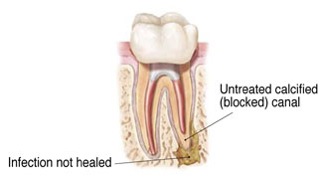Procedures
___________________________________________________________________________________
Retreatment
As with any other dental or medical procedures, a tooth may not heal properly after the initial root canal treatment. In such cases, the tooth may require a secondary Endodontic procedure referred to as a Root Canal Retreatment. There are a variety of reasons to need such treatment:
• Narrow or curved canals that were not treated during the initial procedure
• Complicated canal anatomy undetected in the first procedure
• Delayed placement of the crown or other restoration following the Endodontic treatment
• The restoration not preventing salivary contamination to the inside of the tooth
 In other cases, issues such as deep decay, trauma (fracture), loose and/or cracked fillings can result in new infection of your tooth that was successfully treated.
In other cases, issues such as deep decay, trauma (fracture), loose and/or cracked fillings can result in new infection of your tooth that was successfully treated.
Prompt and proper post-operative care is essential in minimizing these risks and ensuring long-term success.
What to Expect during Retreatment?
The Endodontist will reopen the tooth to gain access to the root canal filling material. In many cases, complex restorative materials – crown, post and core material – must be disassembled and removed to permit access to the root canals.
After carefully removing the canal filling and examination of the inside of the tooth, the Endodontist will shape and fill the canals. A temporary filling will be placed to seal the tooth until it is restored by your general dentist.
Once the retreatment is completed, you must return to your general dentist as soon as possible to have your tooth properly restored.
Whenever possible, it is best to save your natural tooth. Retreated teeth can function well for years, even for a lifetime.
Advances in technology are constantly changing the way root canal treatment is performed. We strive to provide the best care available to resolve your dental needs.

